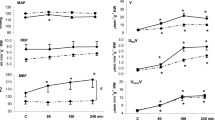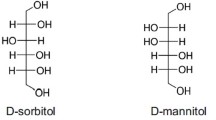Summary
-
1.
200–270 g rats in Pentobarbital or Inactin narcosis are prepared for bilateral occlusion of the common carotid arteries without damaging the accompanying nerves (donor animals). An external jugular vein is cannulated in the cephalad direction. In hydrated, conscious rats (test rats) diuresis and excretion of electrolytes is followed continuously by a special method. The effect on diuresis and saluresis of 0.2–1 ml-samples of the donor's jugular vein blood (applied as exchange-transfusion into the V. cava of the test rat) is assayed before and after occluding the carotid arteries for 10 min.
-
2.
After carotid occlusion the jugular vein blood of non-hydrated donors shows a very large antidiuretic activity (equivalent to 505 ± 373 µU ADH/ml plasma) and a modest saluretic effect. Control blood samples have hardly any demonstrable effect under the above conditions.
-
3.
Overhydration of the donor with water or saline completely abolishes both activities when the water load is retained by the animal. Antidiuretic and saluretic activities appear again on excretion of the given water load. Thus, (a) saluretic activity is invariably connected with antidiuretic activity, and (b) hydration suppresses liberation of an antidiuretic-saluretic agent.
-
4.
Carotid occlusion raises systemic blood pressure (by 8–30 mm Hg), augments glomerular filtration rate and increases elimination of Na and K in the rat.
-
5.
Both, exogenous ADH given as single dosis of 120 µU into the V. cava and endogenous ADH liberated by haemorrhage of very short duration have saluretic properties in the hydrated rat.
-
6.
The results suggest that the substance appearing in jugular vein blood after carotid occlusion is ADH.
Zusammenfassung
-
1.
200–270 g schwere Wistarratten werden in Nembutalbzw. Inactinnarkose operativ auf eine beidseitige Abklemmung der Aa. carotides communes ohne Verletzung der begleitenden Nerven vorbereitet (Spendertiere). Eine V. jugularis ext. wird mit einem kopfwärts gerichteten Katheter versehen. Die Diurese und die Elektrolytausscheidung wacher, hydrierter Ratten wird nach einem besonderen Verfahren fortlaufend registriert. Blutproben (0,2–1 ml) werden aus der Jugularis vor und nach 10minütiger Abklemmung beider Carotiden des Spenders entnommen und im Austauschverfahren dem Testtier in die V. cava caudalis appliziert.
-
2.
Bei nichthydrierten Ratten läßt sich eine erhebliche antidiuretische (entsprechend 505 ± 373 µE ADH/ml Plasma) und eine mäßige saluretische Aktivität im Jugularvenenblut nach der Carotisabklemmung nachweisen. In Kontrollblutproben sind unter diesen Bedingungen kaum solche Aktivitäten nachzuweisen.
-
3.
Das Blut von Tieren, die mit Wasser oder physiologischer Kochsalzlösung überhydriert wurden, hat bei Carotisabklemmung weder antidiuretische noch saluretische Eigenschaften, wenn das verabreichte Wasser retiniert wird. Beide Aktivitäten erscheinen wieder, wenn das retinierte Wasser ausgeschieden wird. Demnach ist (a) die saluretische Aktivität stets mit der antidiuretischen verknüpft und (b) das Auftreten des antidiuretisch-saluretischen Prinzips durch eine Hydrierung gehemmt.
-
4.
Die Okklusion der Carotiden bewirkt bei der Ratte eine Blutdruckerhöhung von 8–30 mm Hg, eine Steigerung der glomerulären Filtrationsrate und eine Erhöhung der Na- und K-Ausscheidung.
-
5.
Einzeldosen von 120 µE exogenem ADH und endogenes ADH, das durch eine kurzdauernde Hämorrhagie freigesetzt wurde, haben saluretische Eigenschaften bei der hydrierten Ratte.
-
6.
Die Ergebnisse zeigen, daß die Substanz, die im Jugularvenenblut nach Carotisabklemmung erscheint, wahrscheinlich das antidiuretische Hormon ist.
Similar content being viewed by others
Literatur
Anslow, W. P., Wesson, L. G.: Some effects of pressor-antidiuretic and oxytocic fractions of posterior pituitary extract on sodium, chloride, potassium and ammonium excretion in the dog. Amer. J. Physiol.182, 561 (1955).
Aziz, O.: Fehlende humorale Übertragbarkeit der Salurese nach sehr raschen Blutvolumenerhöhungen. Versuche am gekreuzten Kreislauf mit wachen Ratten. Z. ges. exp. Med.157, 72 (1972).
Aziz, O., Haberich, F. J., Nowacki, P. E.: Technik der Dauerkatheterisierung der V. portae und V. cava caudalis an der wachen Ratte. Naturwissenschaften51, 557 (1964).
Brooks, F. P., Pickford, M.: The effect of posterior pituitary hormones on the excretion of electrolytes in dogs. J. Physiol. (Lond.)142, 468 (1958).
Cort, J. H., Lichardus, B.: The nature of the renal response to the carotid sinus pressor reflex. Hormones and the kidney. London: Academic Press 1963.
Cort, J. H., Rudinger, J., Hagemann, I., Lichardus, B.: Synthetic oxytocin derivatives and the renal handling of sodium — a relation to the saluresis accompanying pressor reflexes? 3. Symposion der Ges. f. Nephrologie 1964, Berlin. Bern-Stuttgart: Huber 1964.
Cort, J. H., Dousa, T., Pliska, V., Lichardus, B., Safarova, J., Vranesic, M., Rudinger, J.: On the nature of the saluretic activity of blood during carotid occlusion in the cat. Amer. J. Physiol.215, 921 (1968).
Dresser, T. P., Lynch, R. E., Schneider, E. G., Knox, F. G.: Effects of increases in blood pressure on pressure and reabsorption in the proximal tubule. Amer. J. Physiol.220, 444 (1971).
Greene, E. C.: In: The rat in laboratory investigation. Philadelphia: Lippincott 1949.
Kirchheim, H., Gross, R.: Das Verhalten der Nierendurchblutung und des Nierenumfangs bei Blutdrucksteigerungen durch doppelseitigen Carotisverschluß oder Schrittmachertachycardie. Pflügers Arch.320, 79 (1970).
Martinez-Maldonado, M., Eknoyan, G., Suki, W. N.: Natriuretic effects of vasopressin and cyclic AMP: possible site of action in the nephron. Amer. J. Physiol.220, 2013 (1971).
Perlmutt, J. H.: Contribution of carotid and vagal reflex mechanisms. Fed. Proc.27, 1149 (1968).
Sawyer, W. H.: Posterior pituitary extract and excretion of electrolytes by the rat. Amer. J. Physiol.169, 583 (1952).
Sedlakova, E., Lichardus, B., Cort, J. H.: Plasma saluretic activity: Its nature and relation to oxytocin analogues. Science164, 580 (1969).
Share, L.: Control of plasma ADH titer in hemorrhage: Role of atrial and arterial receptors. Amer. J. Physiol.215, 1384 (1968).
Share, L., Levy, M. N.: Cardiovascular receptors and blood titer of antidiuretic hormone. Amer. J. Physiol.203, 425 (1962).
Somlyay, L., Thron, H. L., Petran, K., Carl, G.: Die Nierenfunktion während doppelseitiger Carotisabklemmung am wachen Hund. Pflügers Arch. ges. Physiol.275, 117 (1962).
Vogel, P., Aziz, O., Haberich, F. J.: Das Vasopressin-Wasser-Äquivalent unter verschiedenen Ausgangsbedingungen an der wachen Ratte. Pflügers Arch.307, 79 (1969).
de Wardener, H. E., Mills, I. H., Clapham, W. F., Hayter, C. J.: Studies on the efferent mechanism of the sodium diuresis which follows the administration of intravenous saline in the dog. Clin. Sci.21, 249 (1961).
Author information
Authors and Affiliations
Rights and permissions
About this article
Cite this article
Aziz, O. Über die antidiuretische und saluretische Aktivität des Jugularvenenblutes narkotisierter Ratten bei einer beidseitigen Abklemmung der A. carotis communis. Res. Exp. Med. 160, 136–151 (1973). https://doi.org/10.1007/BF01852251
Received:
Issue Date:
DOI: https://doi.org/10.1007/BF01852251




